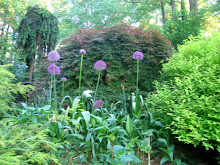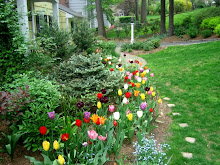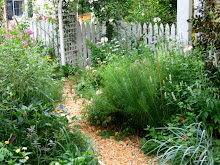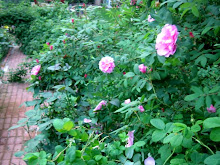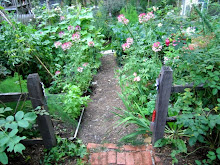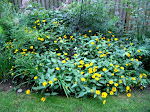Welcome to Heirloom Gardener
Tuesday, June 30, 2009
Iceburg (1958) Floribunda Rose in the Oak Tree Garden
Posted by
Julia Erickson
at
8:56 PM
4
comments
![]()
![]()
Labels: Roses
Molineaux David Austin Rose in the Front Border

Posted by
Julia Erickson
at
8:44 PM
0
comments
![]()
![]()
Labels: Roses
Old Blush (1752) China Rose in the Front Border
Posted by
Julia Erickson
at
8:41 PM
0
comments
![]()
![]()
Labels: Roses
Baby Faraux (1924) Polyantha Rose outside the Children's Garden
Posted by
Julia Erickson
at
8:38 PM
0
comments
![]()
![]()
Labels: Roses
Delphinium in front of the Bird Garden
Posted by
Julia Erickson
at
6:00 AM
6
comments
![]()
![]()
Labels: Annuals/Biennials and Perennials
Monday, June 29, 2009
Ladybug (Coccinellidae) Pupai

Posted by
Julia Erickson
at
9:46 PM
2
comments
![]()
![]()
Labels: Wildlife in the Garden
Tuesday, June 23, 2009
How to Protect the Vegetable Garden from the Groundhog, Part 2: Adding Chicken Wire and Gates to an Open Post and Rail Fence
When originally conceived, the Children's Garden was going to be a place to grow creative things with the children, like a tee pee made of vines, which we did the first year, and other beds planted and maintained by the children. Thus, the original fencing around the garden was a post and rail fence with three open entryways without gates, which you can see here. The only part of the garden remaining from that original conception is my older daughter's flower garden in the upper left hand corner. Over time, the children's interest in growing vegetables increased, so we replaced the short raised beds with extra-tall raised beds, which you can see and read about here. The extra-tall raised beds improved our vegetable production significantly, but as a result, we also attracted more pests, particularly those hungry, no-good rabbits and groundhogs.
 In the middle, you can see the simple wooden gate built to fit the space between the two posts. It is built with the same one by two's left-over from building the chicken wire raised bed cover. Because I wanted to keep pests from crawling under the gate, it is actually resting on the ground. Instead of hinges, it has long, easy, on-and-off ties on the top and bottom attached to each of the side posts.
In the middle, you can see the simple wooden gate built to fit the space between the two posts. It is built with the same one by two's left-over from building the chicken wire raised bed cover. Because I wanted to keep pests from crawling under the gate, it is actually resting on the ground. Instead of hinges, it has long, easy, on-and-off ties on the top and bottom attached to each of the side posts.*A Chicken Wire Raised Bed Cover
Posted by
Julia Erickson
at
10:07 PM
4
comments
![]()
![]()
Labels: Children's Garden, Gardening Tools and Structures, Heirloom and Organic Food, Pest Control
Friday, June 19, 2009
Front Yard Gardening Design Challenge: Five Ideas for the Downward Sloping Front Yard Garden
This month's Garden Bloggers' Design Workshop at Gardening Gone Wild is on Front Yards. This was one of the topics last year, and given what a common design challenge it is, they've decided to revisit it. Last year, I posted the saga of how I've continued to change my front yard garden from something that was once unremarkably suburban to a series of mixed borders. You can read that prior post here. For this year's workshop, I thought I'd share some hard-earned lessons on a particular design challenge that I've faced, but is not usually addressed in gardening books or magazines: the downward sloping front yard garden.
.
If I tell you that I live on a hill, then you probably imagine a house on the top of a hill. If you don't have a flat front yard, it's more likely that you have an upward sloping one. But what if you have a downward sloping one? How can you make it as beautiful and as inviting as any other? Here are some of the design elements that have worked for me:
.
.
.
.
.
.
Related posts: Heirloom Gardener's Four-Year Makeover of Her Front Garden and The Egg Garden in June: Replacing the Overgrown Evergreen in the Front Corner of Our Home with a Mixed Bed
Posted by
Julia Erickson
at
11:28 PM
14
comments
![]()
![]()
Labels: Front Border, Garden Bloggers' Design Workshop, Goldberry Hill
Gardening Gone Wild's Picture This Photo Contest for June: Roses
Submit your entries by June 22 here. Now which of my rose photos are my favorites?
Posted by
Julia Erickson
at
11:25 PM
0
comments
![]()
![]()
Labels: Picture This Photo Contest, Roses
Thursday, June 18, 2009
Tausendschon (1906) or Thousand Beauties Rambler Rose on the Fort in the Walled Garden
On the side of the fort in the Walled Garden, I have a clematis, Fragrant Spring, and a rose, Tausendschon, growing together on a trellis. The clematis blooms a couple of weeks before the rose, which you can see here.
.
Related post: How to Build a Children's Playhouse (the Fort)
.
Posted by
Julia Erickson
at
10:38 PM
6
comments
![]()
![]()
Labels: Roses
Wednesday, June 17, 2009
Mayflower (2001) David Austin English Rose in the Hydrangea Border
Posted by
Julia Erickson
at
11:23 PM
1 comments
![]()
![]()
Labels: Roses
Gardenia (1899) Rambler Rose on the Arbor to the Walled Garden
Posted by
Julia Erickson
at
11:13 PM
0
comments
![]()
![]()
Labels: Roses
Hansa (1905) Rugosa Rose in the Front Border
Posted by
Julia Erickson
at
10:51 PM
0
comments
![]()
![]()
Labels: Roses
Excellenz von Schubert (1909) Polyanthus Rose in the Front Border
Posted by
Julia Erickson
at
10:49 PM
0
comments
![]()
![]()
Labels: Roses
A Different Garden Tour of Philadelphia Gardens from The New York Times
As a follow-up to my posts about visiting gardens in Philadelphia over Memorial Day weekend, I was intrigued to see Judith Dobrzynski's article in The New York Times about her own Philadelphia garden tour. In her article "Philadelphia's Gardens of Delight" from June 5th, she visited four gardens, including two I recently visited, Chanticleer and Scott Arboretum at Swarthmore. She also visited Jenkins Arboretum (featuring azaleas and rhododendrons that I have not yet visited) and Bartram's Garden (which I have visited, but is unfortunately in a very rough part of town). Ms. Dobrzynski needs to add Morris Arboretum and Linden Hill Nursery to her next visit.
For the full article, including slide show, click here. She concludes: "An overview of gardens open to the public in the Philadelphia area is at http://www.greaterphiladelphiagardens.org/."
Posted by
Julia Erickson
at
10:16 PM
0
comments
![]()
![]()
Labels: Botanical Gardens
Tuesday, June 16, 2009
Thomas Affleck (1998) from Antique Rose Emporium outside the Children's Garden
Posted by
Julia Erickson
at
10:59 PM
1 comments
![]()
![]()
Labels: Roses
Cardinal de Richelieu (1840) Gallica Rose in the Long Border
Posted by
Julia Erickson
at
10:55 PM
0
comments
![]()
![]()
Labels: Roses
Belinda (1936) Hybrid Musk Rose in the Bird Garden
Posted by
Julia Erickson
at
10:49 PM
4
comments
![]()
![]()
Labels: Roses
Monday, June 15, 2009
Garden Bloggers' Bloom Day - June 2009: Roses and Much, Much More (New Jersey, Zone 6b)

Posted by
Julia Erickson
at
10:14 PM
8
comments
![]()
![]()
Labels: Garden Bloggers' Bloom Day, Roses
Search Heirloom Gardener
Labels
- About Blogging
- Annuals/Biennials and Perennials
- Autumn Garden
- Books and Movies
- Botanical Gardens
- Bulbs and Tubers
- Children's Garden
- Chrysanthemum
- Clematis
- Container Gardening
- Crocus tommasiniasus roseus
- Cut and Forced Flowers
- Cutting and Rose Gardens
- Dahlias
- Deep Thoughts About Gardening
- Egg Garden
- Fences Arbors Walls and Paths
- Floral arrangements
- Front Border
- Fun Stories About Gardening
- Garden Bloggers' Bloom Day
- Garden Bloggers' Design Workshop
- Garden Planning
- Gardening Blogs
- Gardening Tools and Structures
- Gardening with Children
- Goldberry Hill
- Heirloom and Organic Food
- Hibiscus
- Holidays
- Hydrangeas
- Japanese Beautyberry
- Lilies
- Mixed Borders
- New Jersey / Local Interest
- Nurseries
- Online Gardening Resources
- Peonies
- Pest Control
- Picture This Photo Contest
- Piet Oudolf
- Poppies
- Propagation and Seeds
- Pruning and Maintenance
- Roses
- Seed Heads
- Self Seeders
- Shrubs
- Spring Garden
- Summer Garden
- Trees
- Wildlife in the Garden
- Winter Garden
- Zinia
Blog Archive
-
▼
2009
(257)
-
▼
June
(41)
- Iceburg (1958) Floribunda Rose in the Oak Tree Garden
- Molineaux David Austin Rose in the Front Border
- Old Blush (1752) China Rose in the Front Border
- Baby Faraux (1924) Polyantha Rose outside the Chil...
- Delphinium in front of the Bird Garden
- Ladybug (Coccinellidae) Pupai
- How to Protect the Vegetable Garden from the Groun...
- Front Yard Gardening Design Challenge: Five Ideas...
- Gardening Gone Wild's Picture This Photo Contest f...
- Tausendschon (1906) or Thousand Beauties Rambler R...
- Mayflower (2001) David Austin English Rose in the ...
- Gardenia (1899) Rambler Rose on the Arbor to the W...
- Rosa Virginiana in the Bird Garden
- Hansa (1905) Rugosa Rose in the Front Border
- Excellenz von Schubert (1909) Polyanthus Rose in t...
- A Different Garden Tour of Philadelphia Gardens fr...
- Thomas Affleck (1998) from Antique Rose Emporium o...
- Cardinal de Richelieu (1840) Gallica Rose in the L...
- Belinda (1936) Hybrid Musk Rose in the Bird Garden
- Garden Bloggers' Bloom Day - June 2009: Roses and...
- Oriental Poppies (Papaver orientale) in the Egg Ga...
- Midsummer Garden Party at Fordhook Farm featuring ...
- Some of the peonies in bloom throughout the gardens
- Pictures of Piet Oudolf's High Line Gardens
- NatureFind: how to find public parks, campsites, a...
- Styrax japonicus tree and flowers in bloom on Gold...
- Zombie Blogs: Why 95% of Blogs Are Abandoned
- Piet Oudolf's High Line Gardens Open in New York City
- The Egg Garden in June: Replacing the Overgrown E...
- Green Hour: how to find public parks, campsites, ...
- WSJ story about Danielle Hahn's Rose Story Farm by...
- Ask Heirloom Gardener: Are Heirloom Roses Hard to...
- The Rose Garden in Summer: Madame Ernest Calvat (...
- The Rose Garden in Summer: Madame Plantier (1835)...
- The Rose Garden in Summer: Ispahan (1832) Damask ...
- The Rose Garden in Summer: Therese Bugnet (1950) ...
- The Rose Garden in Summer: Leda (1827) Damask Rose
- The Rose Garden in Summer: Alchymist (1956)
- The Rose Garden in Summer: Russell's Cottage Rose...
- The Rose Garden in Summer: Great Western (1840) B...
- The Rose Garden in Summer, Part I: A Walk Down th...
-
▼
June
(41)




























































